||| FROM ELAINA THOMPSON and BILL SYMES for ISLANDS’ OIL SPILL ASSOCIATION |||
The San Juan Islands’ miles of beautiful shoreline are amongst their greatest attractions to residents and visitors alike, but also one of their greatest vulnerabilities. With ever-increasing traffic of both pleasure boats and commercial vessels in the Salish Sea, the danger of oil pollution is ever-present. Puget Sound hosts an extensive salvage industry well-equipped to mitigate oil spills, but getting the equipment and people to the Islands takes time – time in which a spill can morph from minor and manageable to a major challenge, with much damage already done. For the first few critical hours after a marine oil spill, the Islands are on their own.
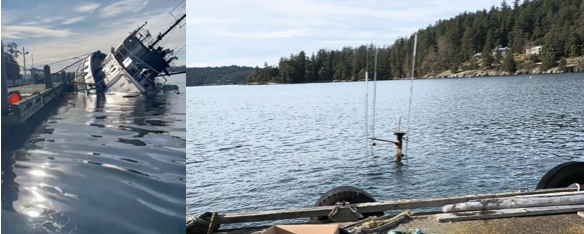
Forty years ago, a group of islanders recognized the need for self-help by forming the Islands’ Oil Spill Association (IOSA) to provide what industry cannot: rapid site assessment and initial response to marine oil spills in local waters. With a small professional staff, trained volunteers, and spill mitigation equipment cached in strategic locations, IOSA fills the gap within the first critical 24-hours when an incident occurs in San Juan County. For minor or unknown sheens, IOSA’s only role may be feeding the immediate critical information to federal and state authorities to prevent resources from being deployed when unnecessary. For larger incidents, IOSA feeds critical information, and when directed, begins initial mitigation measures until agency and industry resources are able to arrive on scene to take over.
Just over a year ago, a dramatic vessel sinking in West Sound on Orcas Island highlighted IOSA’s rapid response capability.
Saturday, November 18, 2023, was pleasant, calm, and partly sunny. At West Sound Marina, boat owners and guests enjoyed the fine weather and the opportunity to “mess about in boats”. At about 11am, however, this bucolic scene was rudely interrupted: a boat was sinking! And not just any boat, but El Capitan, an 80 foot long steel tug and one of the largest and heaviest vessels in the marina. After a few moments of frantic effort, with marina staff taking an axe to mooring lines two inches thick to avoid having the tug take the dock with it, El Capitan settled to the bottom of West Sound, in roughly 35 feet of water, just off the end of A Dock. Only the top of its radio mast was visible.
El Capitan was built in 1944 for the US Army. It was subsequently used in the Alaskan timber industry and then brought to the San Juan Islands as a pleasure craft and berthed at West Sound Marina until it was eventually abandoned. In late 2020, the Marina called in the San Juan County Derelict Vessel (SJC DV) Program for help with removal of the vessel. After a series of phone calls and a near sinking event the next day, the SJC DV program secured funding from the State Department of Natural Resources (DNR) for emergency services to temporarily stabilize the vessel from sinking and to remove 750 gallons of diesel oil from boat’s main fuel tanks along with other potential pollution sources. Although most of the pollution threat was removed during this process, the tug’s 12-cylinder main engine (with cylinders the size of dinner plates), three diesel gensets, hydraulic equipment and aging exhaust components inevitably retained significant amounts of petroleum products, leaving the local environment still at risk for pollution. Efforts to remove the vessel continued, but a number of factors delayed the process, and in late 2023, El Capitan’s time ran out.
As the vessel submerged on November 18, 2023, oil rose to the surface and began spreading through the surrounding waters, threatening contamination of boats, structures, shoreline, and wildlife. Marina staff notified the US Coast Guard of the sinking and risk of pollution through the National Response Center, which alerted the SJC Department of Emergency Management who in turn notified Elaina Thompson, Executive Director of IOSA. Within minutes, the on-duty USCG Watch Captain reached Elaina by phone, saying “I’m sure you’ve seen the NRC report come through. Can your team get down to the scene for an assessment asap? Do you have boom nearby? Do you think you can get boom around that sunken vessel?”
“I can have responders on site within 20 minutes,” Elaina replied. “I’ll be back with an assessment, photos, and our recommendations in less than half an hour.”
Following Elaina’s texts, a crew of IOSA Tier One (response-trained) volunteers quickly assembled on site, with the most experienced volunteer, Becky Hawley (a 20+ year veteran responder with IOSA), acting as operations lead. “Yeah, it looks pretty bad,” Becky told Elaina over the phone. “There’s oil rising to the surface above the tug and it’s already spreading. The smell is pretty bad too.”
“Do you feel you can safely get boom around that vessel with the team and resources you have available, Becky?” Elaina asked.
“The weather is calm, we have the marina staff and boats in the water, and enough IOSA Tier One volunteers to lead,” Becky said, thinking through the steps. “Yes Elaina, I think we can get this done safely.”
“Great news. Be careful, make sure everyone follows your lead and call things off if anything starts to feel unsafe,” Elaina responded. “Keep me informed, I’ll keep the Coast Guard and other agencies in the loop. Your trailer should be there in about 10 minutes.”
The standard technique for preventing the spread of floating oil is to surround it with floating barriers called containment boom. Containment boom is secured by anchor systems in 50-100’ sections that can be bridled to a dock or free-floating in water. Once the floating oil is contained, then sorbent materials designed to pick up petroleum products without absorbing water are used to mop up the oil on the surface. IOSA maintains fourteen enclosed trailers housing containment boom, anchor systems, sorbent materials, and other response supplies within San Juan County. Marina staff helped IOSA volunteers back trailer #16 from the Eastsound Fire Station onto the wharf, where several volunteers started moving the awkward hundred-foot-long sections of containment boom from the wharf to the seaplane dock for immediate deployment.
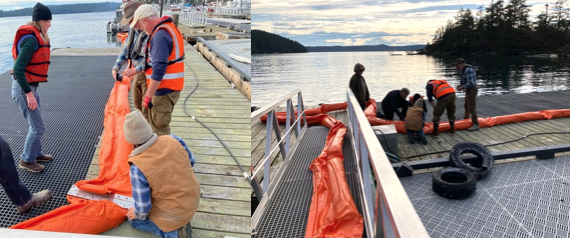
At that point the boom sections needed to be towed into place, hooked together to form a roughly pentagonal “corral” for the oil surfacing from the tug, the corners anchored to the sea bottom. IOSA trailers provide the necessary anchors and rode to accomplish this set-up, along with light buoys to warn vessels away from the boom at night. An IOSA Tier One volunteer (and retired USCG veteran) boarded one of the boats to help Becky Hawley in the marina skiff direct boom siting and anchoring. Meanwhile, other IOSA Tier One volunteers and marina staff deployed sorbent materials in key positions around the marina.
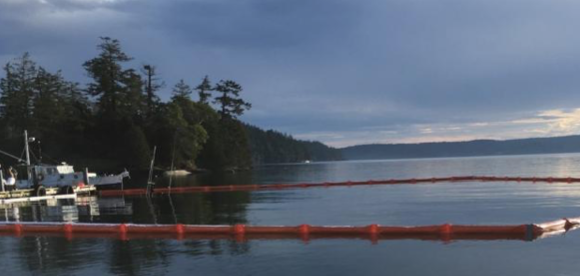
As dusk began to settle around West Sound, 500’ of orange IOSA containment boom lined with sorbents now encircled the large tug resting on the bottom. WA State Department of Ecology (DOE) workers were now on scene collaborating with IOSA to adjust the final components of the containment, and all involved seemed to sigh with a bit of satisfaction, concern, and exhaustion all mixed into one collective breath.
“Nice work everyone,” one of the DOE folks said to the IOSA team and community members still hanging around. “Now we’ll need to make a plan to keep an eye on this setup, because as the tide and weather changes, so will everything we’ve put in place here today.”
For the next few weeks, Elaina coordinated with the USCG, DOE, West Sound Marina and IOSA volunteers to continually monitor the oil leaking from the wreck and its containment. Downwind from the marina (in the usual southerlies) is the mouth of Crow Creek, a potential spawning ground and gathering area for waterfowl. Volunteers monitored the surface oil appearing in that area for recoverability and wildlife contamination (none was ever found). Marina staff took over the responsibility and maintenance of the boom and sorbents, re-anchoring the boom when storms blew it out of place, and changing the sorbents when necessary. Oil continued to “burp” from the wreck until the day it was pulled from the water, though more slowly as time went on.
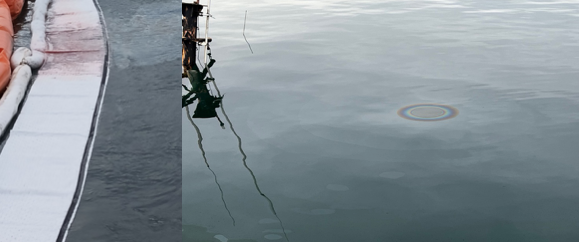
The necessary final step was removal, which was a multi-million-dollar process of lifting, transport and disposal. El Capitan was an abandoned vessel when it sank, and the lack of an identifiable legal owner complicated negotiations between USCG, several County and State departments, the Marina and its Insurer. After months of negotiations and discussions, an agreement was reached, contracts were let, and equipment was moved into place. On June 19, seven months after the sinking, a sizable crowd watched as a huge crane raised El Capitan and deposited the hulk on a barge for its final voyage to the breakers.
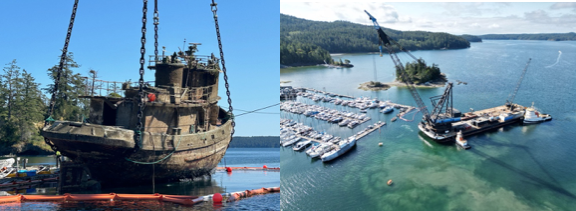
As an oil spill, this incident was minor, largely thanks to the earlier action of the West Sound Marina, the SJC DV program, and the State DNR to empty El Capitan’s main fuel tanks. Except for some damage to the end of A dock, little visible after-effect remains. IOSA was able to fulfill its first-responder role by providing initial response and containment with the help of marina staff and a few key community volunteers. Its Tier One volunteer training program paid off: the volunteers did what was required competently, quickly, and most importantly, safely. IOSA contributed to the resolution of El Capitan’s wreck in exactly the way its charter intends.
Islands’ Oil Spill Association is a one-of-a-kind spill response organization in the San Juan Islands, and one of very few non-profit, community-based, spill response organizations in the Nation. For more information, visit http://iosaonline.org. If you see oil in the water, report it to WA State at 800-OILS-911 or the USCG National Response Center at 800-424-8802. Both of these reporting agencies call on IOSA to respond within San Juan County.
The authors would like to acknowledge and thank Betsy Wareham, Mary Gropp, Brendan Cowan, Becky Hawley, Marta Green, and Kari Koski for their assistance in compiling this report.
**If you are reading theOrcasonian for free, thank your fellow islanders. If you would like to support theOrcasonian CLICK HERE to set your modestly-priced, voluntary subscription. Otherwise, no worries; we’re happy to share with you.**
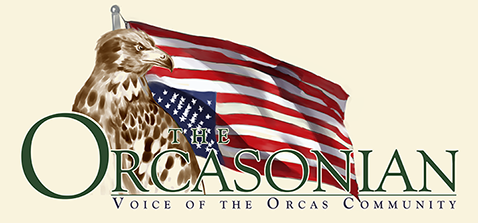
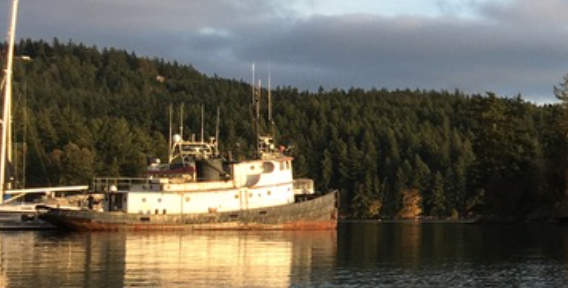

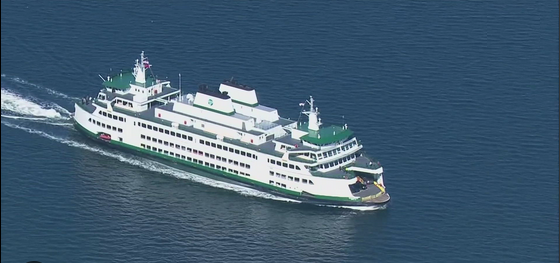
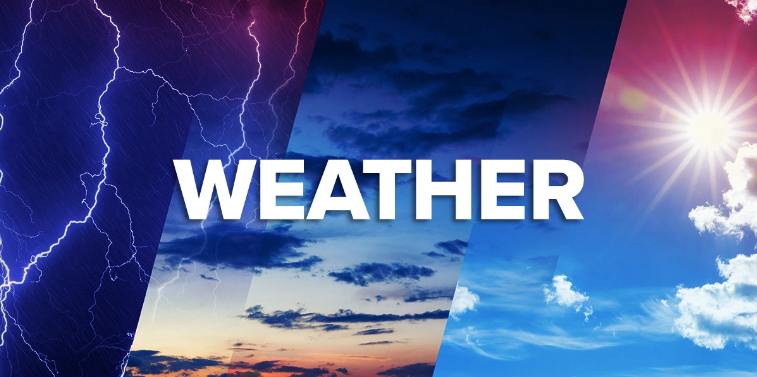




The staff and volunteers of IOSA are invaluable for protecting the wildlife that lives and visits our marine waters and our shorelines from fossil fuel pollution. I am so grateful for their expertise and rapid response. Many thanks to the community members and marina staff who were also essential in limiting the damage at West Sound Marina.
Good job Betsy and your whole crew. Glad that the Chiefton is gone.